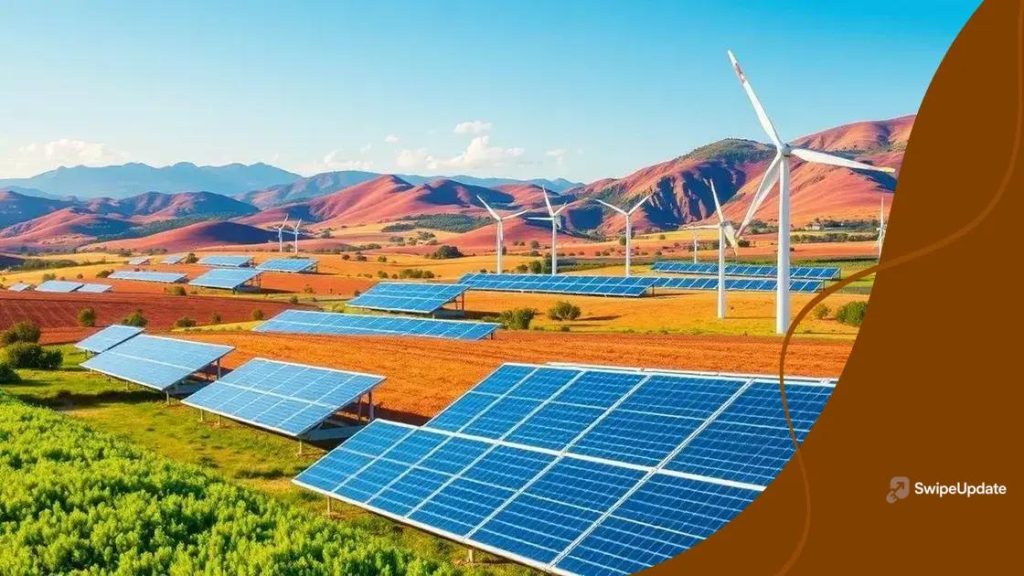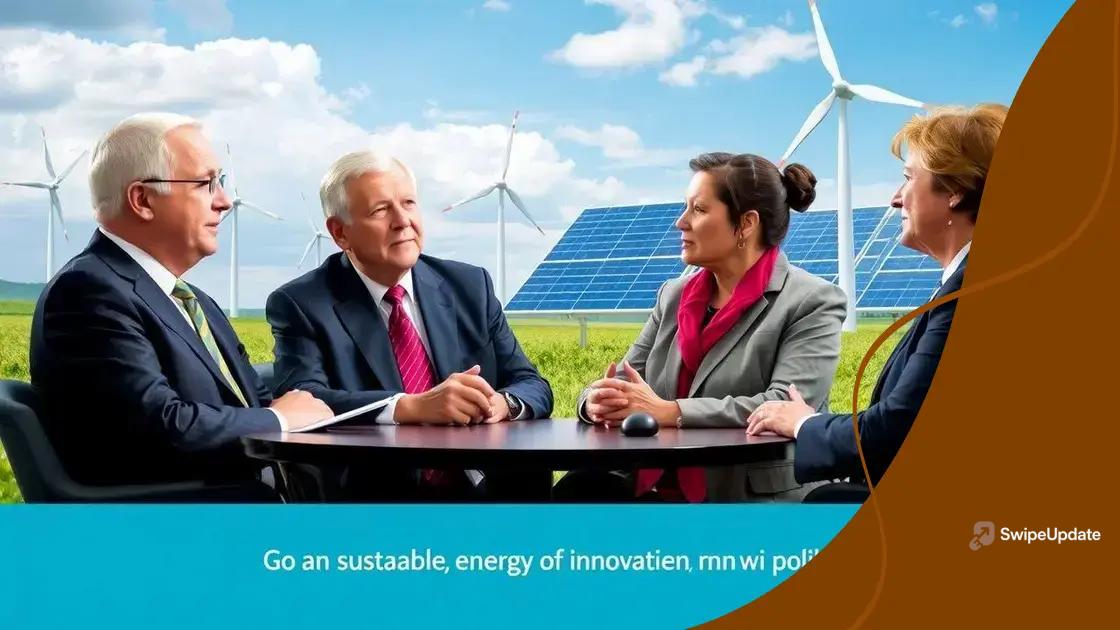Developments in renewable energy: what to expect soon

Developments in renewable energy focus on innovations in solar, wind, and energy storage technologies, aiming to enhance efficiency, reduce costs, and promote sustainability to combat climate change.
Developments in renewable energy are not just reshaping landscapes; they’re changing how we power our lives. With new innovations emerging, have you ever wondered how these shifts can impact your daily routine and future opportunities?
Latest technologies in renewable energy
The latest technologies in renewable energy are revolutionizing how we harness natural resources. As we face climate change, the urgency to innovate has never been greater. Let’s dive into some exciting advancements that are making waves in the industry.
Solar Power Innovations
Solar energy technology has evolved tremendously over the years. New photovoltaic cells can convert more sunlight into electricity, making solar panels even more efficient. With the advent of solar tracking systems, panels can follow the sun’s path, maximizing energy capture.
- Increased efficiency of photovoltaic cells.
- Solar tracking systems that enhance energy output.
- Building-integrated photovoltaics (BIPV) for dual-use structures.
Wind Energy Developments
Wind energy also continues to grow, with advancements in turbine design and placement. Offshore wind farms are becoming more common, capturing stronger and more consistent winds than those found on land. This has encouraged investment and development in this area.
Moreover, vertical-axis wind turbines are gaining traction as a more compact option for urban environments. These innovations allow for better energy generation in various settings.
Energy Storage Solutions
One of the biggest challenges in renewable energy has been storage. However, new battery technologies, like lithium-ion and solid-state batteries, improve energy storage capabilities. These allow for efficient energy retention, ensuring that we utilize the maximum potential of renewable sources.
- Innovative battery chemistries for improved storage.
- Flow batteries for longer-lasting energy retention.
- Grid energy storage systems for balancing supply and demand.
In addition, hydrogen storage solutions are emerging, presenting a promising avenue for storing excess renewable energy. This can be especially useful when demand fluctuates.
As these latest technologies continue to progress, integrating them into our energy systems will be crucial. We have the potential to create a more sustainable and efficient energy landscape, making the future of energy brighter than ever.
Impact of renewable energy on the environment
The impact of renewable energy on the environment is a crucial topic in today’s world. As we look for ways to reduce our carbon footprint, it’s essential to understand how these energy sources can benefit our planet. Renewable energy helps lessen greenhouse gas emissions and other pollutants that result from fossil fuels.
Reduction in Greenhouse Gas Emissions
One of the primary benefits of renewable energy is its ability to significantly reduce greenhouse gas emissions. By utilizing clean sources like wind, solar, and hydroelectric power, we can lower the amount of carbon dioxide (CO2) released into the atmosphere. This, in turn, combats climate change and promotes cleaner air.
- Wind energy produces almost zero emissions.
- Solar power systems contribute significantly to reducing fossil fuel dependence.
- Hydroelectric plants harness energy without releasing carbon.
Preservation of Natural Resources
Another important aspect is how renewable energy contributes to the preservation of natural resources. Unlike fossil fuels, which can deplete and damage ecosystems, renewables use resources that are abundant and naturally replenished. For example, solar panels convert sunlight into energy, while wind turbines harness the wind without exhausting its supply.
These technologies also reduce the need for resource-intensive extraction processes that can harm the environment. By shifting towards renewable energy, we help conserve water, soil, and air quality.
Positive Effects on Wildlife
Transitioning to renewable energy also has a positive impact on wildlife. Traditional energy sources often disrupt habitats through mining and drilling. In contrast, renewable installations can be designed to coexist with nature. Well-planned wind and solar farms can provide educational opportunities while supporting biodiversity.
- Solar farms can be placed on degraded lands.
- Wind turbines can be located in areas that minimize interference with wildlife.
- Agrovoltaics blends agriculture with solar energy production.
As we consider the impact of renewable energy on the environment, it’s evident that these technologies lead to a healthier planet. By adopting these cleaner energy methods, we are investing in the health of our ecosystems and future generations.
The role of government policies in sustainable energy

The role of government policies in sustainable energy is fundamental in promoting clean energy solutions. Governments around the world are implementing strategies to encourage the transition to renewable sources. These policies create a framework that supports innovation and investment in sustainable technologies.
Incentives for Renewable Energy
One primary function of government policies is to provide financial incentives for renewable energy projects. These incentives can include tax credits, grants, and subsidies, making it more affordable for businesses and individuals to invest in clean energy. By lowering the cost of renewable technologies, governments can accelerate the adoption of solar, wind, and other sustainable sources.
- Tax credits for solar panel installations.
- Grants for research in renewable energy technologies.
- Subsidies for energy production from wind farms.
Regulatory Frameworks
In addition to financial support, regulatory frameworks play a significant role in shaping the energy landscape. Policies that set renewable energy targets can drive significant progress. For example, mandates requiring utilities to source a certain percentage of their power from renewable sources encourage investments in clean energy.
Moreover, regulations can ensure that new energy projects meet environmental standards, protecting natural resources and communities. This balance is vital for maintaining public support for renewable initiatives.
International Agreements
Governments also engage in international agreements to foster collaboration in renewable energy efforts. Treaties like the Paris Agreement encourage nations to commit to reducing greenhouse gas emissions. These pacts promote knowledge sharing and technology transfer, enhancing global efforts to combat climate change.
- Commitments to reduce carbon emissions through renewable energy.
- Collaboration on innovative clean technologies.
- Transfer of knowledge between nations on best practices.
In addition, participating in international agreements can enhance a country’s energy security by diversifying energy sources and reducing reliance on fossil fuels. As countries share their experiences and successes, they can learn how to implement effective policies that work best in their contexts.
By setting the right policies, governments can significantly influence the transition to renewable energy. Continued support and commitment to sustainable energy initiatives will pave the way for a cleaner, healthier future.
Challenges facing renewable energy adoption
The challenges facing renewable energy adoption are significant barriers that need to be addressed for a sustainable future. Although renewable technologies offer numerous benefits, there are hurdles that can slow down their implementation. Understanding these challenges is essential for individuals and policymakers alike.
High Initial Costs
One of the main challenges is the high initial cost associated with renewable energy installations. While the long-term savings can be substantial, the upfront investment can be daunting for many individuals and companies. This can deter people from transitioning to renewable sources such as solar and wind.
- Cost of solar panels and installation can be prohibitive.
- Wind turbines require significant investment upfront.
- Energy storage systems, like batteries, add to the initial expenses.
Intermittency Issues
Another significant challenge is the intermittency of renewable energy sources. Solar and wind energy production can vary based on weather conditions and time of day. This unpredictability can create reliability issues for energy grids, making it difficult to maintain a constant energy supply.
To tackle this, a robust energy storage system is needed. However, the costs and technology for effective battery storage are still evolving.
Infrastructure Limitations
Many regions lack the necessary infrastructure to support renewable energy systems. Existing power grids may not be equipped to handle the additional load from renewable sources or integrate them efficiently. Upgrading infrastructure can be costly and time-consuming, which adds another layer of complexity to adoption.
- Need for smarter grid technologies to manage distributed energy sources.
- Infrastructure upgrades may require significant time and investment.
- Remote locations often lack necessary connections to power grids.
In addition, local policies and regulations can also hinder the development of renewable energy projects. Building permits, zoning laws, and environmental regulations vary widely and can create delays or complications for new installations.
Despite the challenges facing renewable energy adoption, progress is being made. By investing in technologies and policies that address these hurdles, we can work towards a cleaner and more sustainable energy landscape for the future.
Future trends in renewable energy developments
The future trends in renewable energy developments are exciting and full of potential. As technology advances, new solutions are emerging that can reshape the energy landscape. These trends not only promise greater efficiency but also enhance the accessibility of renewable energy for everyone.
Advancements in Solar Technology
Solar energy continues to lead the way in innovation. Future trends include the development of more efficient solar panels that can convert a higher percentage of sunlight into electricity. Innovations like bifacial solar panels can capture light from both sides, increasing energy production.
- Integration with smart home technologies for increased efficiency.
- Solar shingles that blend into roofing materials.
- Improved energy storage systems for residential solar users.
Growth of Offshore Wind Energy
Offshore wind energy is expected to expand rapidly in the coming years. The advantages of stronger winds and less visual impact make this energy source particularly appealing. New floating wind turbine technology allows for installations in deeper waters, further opening up potential sites for energy generation.
As these technologies mature, we can expect to see a significant increase in the capacity of offshore wind farms.
Energy Storage Developments
Energy storage is crucial for the reliability of renewable energy sources. Future trends will focus on improving battery technologies and exploring alternatives like pumped hydro storage and hydrogen storage systems. Better storage solutions will help capture excess energy generated during peak production times for use when demand is high.
- Advancements in lithium-ion batteries for faster charge times.
- Exploration of solid-state batteries for higher capacity.
- Hydrogen fuel cells as a long-term energy storage solution.
In addition, policy changes and increased investments will support the growth of these technologies. Governments and private sectors are increasingly recognizing the importance of sustainable energy in addressing climate change.
As we move forward, it is essential to stay informed about these trends in renewable energy developments. The innovations on the horizon will play a key role in creating a sustainable and resilient energy future.
FAQ – Frequently Asked Questions about Renewable Energy Developments
What are the main types of renewable energy?
The main types of renewable energy include solar, wind, hydroelectric, geothermal, and biomass. Each type harnesses natural resources to produce clean energy.
How does solar energy work?
Solar energy works by converting sunlight into electricity using solar panels. These panels contain photovoltaic cells that generate electricity when exposed to sunlight.
What are the benefits of using wind energy?
Wind energy is a clean and renewable source that reduces greenhouse gas emissions. It also creates jobs in manufacturing, installation, and maintenance of wind turbines.
How can government policies support renewable energy?
Government policies can support renewable energy by providing incentives, subsidies, and funding for renewable projects, helping to stimulate investment and adoption of clean technologies.
